|
INDIGENOUS AFRICAN ANTHROPOLOGY OF BRIEFS:
AUTHOR: Dr Baba Mamadi DIANE
Professor at Cairo University, October 2011
Translated by the N'ko Nafadji Sory CONDE and Faya Ismael
Tolno
Conakry, Guinea in December 2011 |
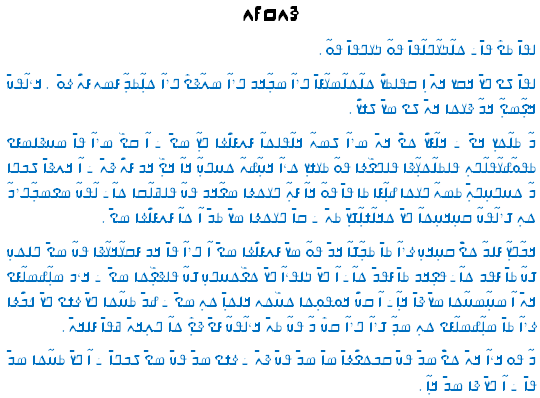 |
The name of God, the Most Gracious, the Most Merciful.
May Allah grant her peace and salvation to the Prophet Muhammad (PBUH)!
The term SOMOOYA designating N'ko civilization consists of three parts of
speech.
The first element (SW) is a name that means a city, the second (MOO) is also a
name that refers to the occupants of the same urban area while the third (YA) is
a suffix of abstraction.
If one adds the first two elements of the term (SOMOO), it is an adjective that
characterizes the nominal being together in one place.
If one adds the three elements of the term, all means all of the qualities (SOMOO):
to be together, live together in one place, with others in social harmony.
This is explained by the fact that at the time before civilization, it was wild
and almost natural step for man as existing higher animals.
Even primates evolved current tamed by man could not show any sign of
independence or freedom.
This is because of the intelligence of man that ancient civilizations have
emerged and allowed him to move beyond animal.
Early on, the man cut the stone for making tools such as knives, arrow, spear at
the ages of stone for his needs at the time prehistoric;
Using wood and stones to hunt, war and prepare traps;
Establish using blast furnaces and wood, iron smelting for metal, to the control
of electricity and the electron current;
Make harpoons, hooks, poles, then needles with bait to catch fish.
Thus, to live and survive in the economic satisfaction of vital needs, humans
have been forced to organize in the early hours of humanity.
This is what led the man to the knowledge and technology.
Each civilization was formed in its natural environment and transmits its
culture through oral language primitives.
The first civilized peoples have generally worn for oral transmission of their
cultures and their literatures.
But for a proper conservation and sustainable values transmitted, the first
types of writing are invented hieroglyphic form in Pharaonic Egypt.
This brought to North Africa - East in antiquity contemporaries from all parts
of the world to Egypt.
The hegemony of the African Egyptian civilization was manifested by the
avant-garde position.
Other people learned the importance of writing, science, starting with the
Phoenicians, Greeks.
This is how the centers of civilization gravitated from one place to another
throughout history.
Other people who had an instrument of conservation of their cultures and
civilization did not need to write.
The durability of this instrument conservatory has filled the void of writing in
African civilizations.
Therefore the absence of writing at home is not synonymous with ignorance.
Of course, others may say that no writing is ignorance, it is not civilized and
ignores its past.
And he who ignores this will have a darker future.
The latter will think he's right.
But this is a general reason acceptable to everyone?
This is a comparative analysis that reveals certain truths as that of a people
written tradition from that of another oral tradition.
For example, the comparison between the mended Sundiata and his contemporaries
in Europe or Asia.
However, the oral tradition becomes negative if it fails to express and maintain
literature and culture.
Depositary to be ignorant in the absence of good instruments conservatives.
The ignorance is not the exclusive preserve of people with oral tradition.
For the preservation of culture, if it is not accompanied by a strong and if it
can not reflect the degree of the nature of change.
It will be a drop and a gradual disappearance will reach the level of
illiteracy.
This is so that today, the only reader of hieroglyphics is an illiterate in the
absence of other knowledge.
As well as the connoisseur of ancient Greek and Latin is an illiterate without
other types of knowledge.
Therefore, it is said that at this period that mail who knows nothing in a
computer is an illiterate.
Literature of the peoples of orality, because of the difficulties inherent in
life, has been eclipsed over the centuries due to changes in hieroglyphics.
Thus, this evolution has seen some people to hegemony and others to decline.
At the time of Emperor Manding Kankou Moussa representing the golden age of
orality, his country was better organized than many people long written
civilization.
For economic reasons, the world prices of gold lowered in the Middle East for
twelve years because of the journey of Mansa Musa in Arabic that were considered
at the time as the most advanced in the world.
Imagine a chef who travels to visit the White House and the U.S. so it fills
with gifts that the world price of gold down to the U.S. stock market for
months, years or decades.
Certainly, this country will be automatically classified the first economic
power in place of the United States.
Since Africans suspected of oral documents disuse, they thought of the
establishment of those writings.
Many people believe that the evolution of Africa has not reached the stage of
writing, while it is they who have learned to other writing.
This is because of this that we want to present samples of African writing and
literature related ending with N'ko.
This writing on which we dwell is the most powerful and most advanced current
entries because of its phonetic and phonological characteristics.
As Africa is the birthplace of writing, so the point of dissemination of the
scriptures, we consider in this regard that the writing is not foreign to
Africa.
This is not a new reality on the African continent.
That is why we will trace the evolution of writing from its origins up to today
and also why the first specimens of writing disappeared without knowing a wide
distribution ..
We will explain and also to understand which direction our writing.
In our understanding, the writing began in Africa.
Consequently, humanity has known many types of writing to various spheres of
influences.
The longevity of a writing may be short.
It depends on the composition and pedagogy of teaching, but no support.
Writing means three things:
· Express a conventional idea as hieroglyphics
· To express its
· Expressing the same time the sound and content.
· Writing syllabic;
· Writing vocalic and consonantal
· Writing vowel, consonant and phonetic.
· Thinking and sound.
· Examples of each type of African writing.
ONE: WRITING ECHANTION IDEOGRAMMIQUE
A-THE hieroglyphics:
The hieroglyphs are the prototypes of the first African writings, even global.
Pharaonic Egypt was the center of this civilization was essentially black, hence
the term (kemun) designating the color black not only in ancient Egyptian, but
also present in Mandinka.
This writing is a sign of the ideas the same way that the figures express the
numbers.
If we write a number, it expresses the number beyond even the syllabic or
alphabetic pronunciations of consonants and vowels. |
|
Tableau
1 |
|
Haoussa
|
N’ko |
chinois |
anglais |
français |
Pronunciation
Idéeograme |
|
sipli |
dokolon |
lìí |
Zero |
zero |
0 |
|
daya |
kelen |
i: |
One |
Une |
1 |
|
biyu |
fila |
a: |
Two |
Deux |
2 |
|
uku |
saba |
sá |
Three |
Trois |
3 |
|
huddu |
nanin |
si |
Four |
Quatre |
4 |
|
biyar |
lolu |
wùú |
Five |
Cinq |
5 |
|
chida |
woro |
liò |
Six |
Six |
6 |
|
bakkoi |
woronwfila |
tyí |
Seven |
sept |
7 |
|
takkoas |
Sekin |
pá |
Eight |
Huit |
8 |
|
Ta:ra |
konondo |
tyòó |
Nine |
Neuf |
9 |
|
Ta:rawa |
Bu: |
tyá |
Plus |
Plus |
+ |
|
debewa |
Ja: |
tyúwi |
Mines |
Moin |
- |
|
daidaida |
ye |
Tyàmu: |
equal |
egale |
= |
|
|
The advantage of this type of writing is
that different languages can be used in reading the same signs and similar
spellings without a difference because everyone can interpret the signs in their
own language even though the pronunciations are different.
This is the case of ideograms used in Asia
that can use several different languages.
Its disadvantages are the fact that we need
to develop and adapt to a specific language for the sake of the cause.
Which leads to the creation of new signs.
But the plurality of signs is a major
obstacle to their understanding or their memory by a person.
SECOND.
THE SOUNDS THAT EXPRESS SCRIPTS:
Consonant entries are used by languages
that have few vowels (3 or 4) taking into account the elision.
The plurality of vowels in African
languages is the Semitic scripts that are not appropriate.
The fact that one can determine the
pronunciation of words by grammatical syntax without mention of vowels makes
such a syllabic script.
That is why the Arabic script does not use vowels a, i and or
while 98 percent of arabic books are written only in consonants.
Ba: Geez Scripture: the Ethiopian people
who experienced the consonantal script Ge'ez before any other African.
Finally, the Ethiopian rajoutèrent vowels.
The Arabic script had followed the same
evolutionary pattern.
However, centuries of Christianity and
their neighborhood combined with the expansion of Islam in North Africa brought
Africans to adopt the amended Semitic writing.
The first specimen of this writing which
may have developed in Ethiopia and its surroundings is writing Ge'ez.
Here's an example: |
 |
This first prototype of writing was
used until 330 AD.
It included 26 letters, all consonants.
It was a cuneiform whose classics are
right in the following table.
Well things have progressed to the
expansion of Christianity in the East with its corollaries of vocalization
alphabetically.
Vowels eventually became decisive.
This is what can be observed today in
writing Amharic of Ethiopia.
Here below, the table of this writing
in its expanded version. |
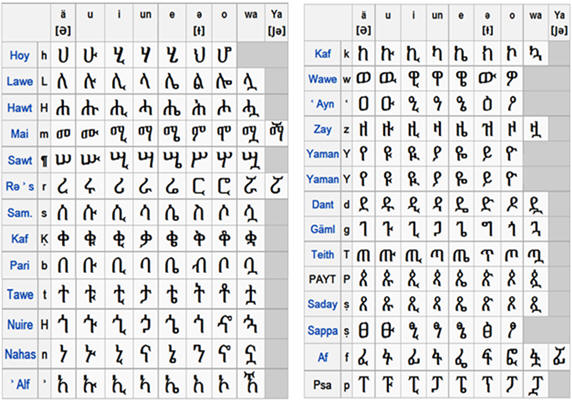 |
Despite the enrichment of the Ge'ez script,
it can not translate all languages of eastern Africa.
That is why the other peoples of the same
region of Africa have found other solutions:
Be: to create another system such as the
Somali ousmanya Either take the derivative of the Latin or Arabic script to
transcribe the language or the ancient writings.
Those who began by creating a new system
are the countries north of the space manden.
They were inspired writing ancient Libyan
itself derived from the Phoenician: the case of writing tifinagh consonant is
written from left to right. |
 |
Writing tifinagh then as one of the latest
versions of the Phoenician script.
This is an ancient script.
It was incorporated into the Unicode along
the N'ko and has 55 letters.
It also exists in Windows 7.
Of those who began by creating a new
writing, there is the case of Somali Ousman Yusuf Kelanadyte.
This is a writing adapted to the
peculiarities of the Somali language.
It was invented between 1920 and 1922.
It is a consonantal writing specifically as
Arabic.
Writing ousmanya spread quickly in Somalia.
But the existence of the Arabic script,
from the Latin, ancient writings eventually destroy its expansion and reduced to
its smallest term.
Here are his letters: |
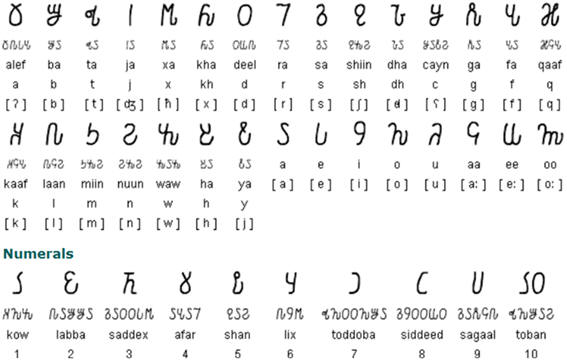 |
Some African nations have not done
research to write a major concern.
That's why they chose the Latin or
Arabic to transcribe their languages.
Unfortunately, some have been
constrained in their choice and many have abandoned.
As well for a language to be
transcribed by a system, it must be reflected in the spelling.
Otherwise, it does not develop.
About people who adopted the Arabic
consonantal alphabet, scholars have never been able to agree on the process
of their harmonies.
The lack of concordance between African
languages too vowel and Arabic writing too little has vocalized that these
experiments have not been able to make significant progress.
Worse, she pushed down efforts.
The reasons are obvious, as the Semitic
alphabet which included starting fifteen letter was accommodated to create
the Arabic alphabet with the addition of diacritical marks in the bottom or
top of the letters to make a total of 28 letters, even after 30 .
Examples of these types of letters: |
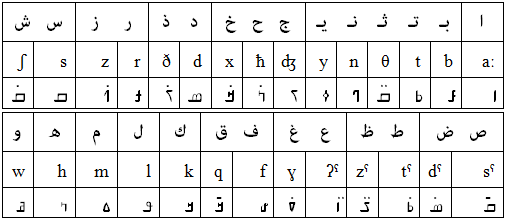 |
This is what Africans have adapted by
adding other signs complementary to the needs of their languages in vowels.
Right now, they did not even think to
record the tones.
A little later, trials transcription of
African languages in Latin began after the colonial conquest.
The fact that the Latin script is better
than Arabic in transcription, it has reinforced the feeling that she is the best
writing.
But as the West has long been known weaknesses in their
writings, they have improved since the 18th century.
That Latin was better advised people not
holding any form of writing.
However the West and Western Africanists
who ignore this information believe it is they who have brought to African
writing while Africa the cradle of st spread of writing where it spread to other
parts of the world.
Suppose, then, as if it was they who
brought us the written word.
Outside the hieroglyphics, is that the remnants of Phoenician
writing it are not visible yet today in North Africa?
is that it is not the Arabs who introduced
for the first time Islam in Arabic script in East Africa, South and West?
Here are examples of the extended Latin: |
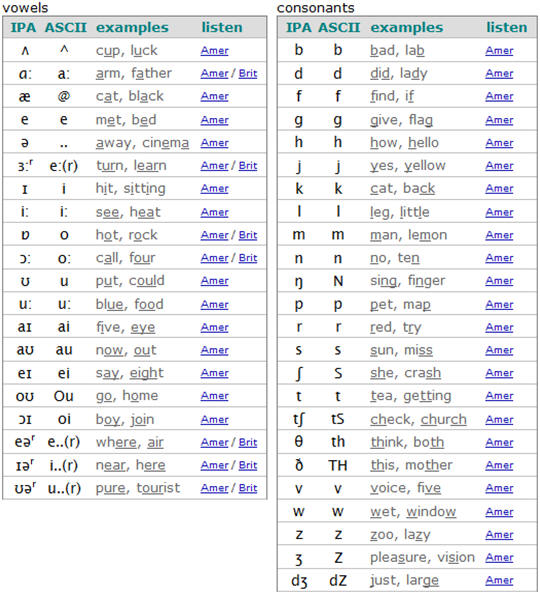 |
The writing system consists of 16 vowels,
18 consonants and three diphthongs visually neutral.
Only owners of an antique can decipher the
real details.
This means that improving a script or alphabet can be possible
only by native speakers of the language, and not by foreigners.
As everyone knows that the Latin script is
not unknown in the transcription of African languages, we will not show an
example here.
Each language has failed to have a recognized standard form of
consolidation of all dialects, especially if they exist beyond the state
borders.
Dissemination of writings consonant in
Africa combined with learning difficulties orientèrent Africans to develop
syllabic writing, which typically assign different signs to all the syllables of
the same language.
That time found that the expansion of the Latin script was
already done in the world.
The existence of all the syllables of a language in syllabic
writing is an asset.
But its disadvantage is that it can not write down the syllables
of another language, not even a dialect of that language.
The syllabic scripts:
Ca: Writing is an illustration of the Vai
syllabic system.
The letter r and all its syllables are absent because the people
Vai does not sound r in their language.
This is the scientific Momolu Doualu Bukele
about 1833.
Fode Soulemana Kante explained that the signs of migration
Konianke the forest to the coast Leone and Liberia were combined to form the Vai
writing.
In addition, he said that Vai is the result of a revelation.
Its author has forgotten signs.
Therefore, these signs do not reach 220.
When Soulemana Kante had tried Arabic in
four years, then Latin in three years, he had learned of the channel vai
Lebanese Kamal Marwa Bouaké in 1944.
He looked up to find the Vai writing.
Happy to have found an African writing, he
realized that the latter unfortunately not including all the sounds.
He understood also learning difficulties,
lack of tonal notation and some letters were a serious obstacle to
understanding.
In our understanding, Vai was the prototype
of the first syllabic scripts known to West Africa.
Its existence has made flow researchers
to this area of the continent. |
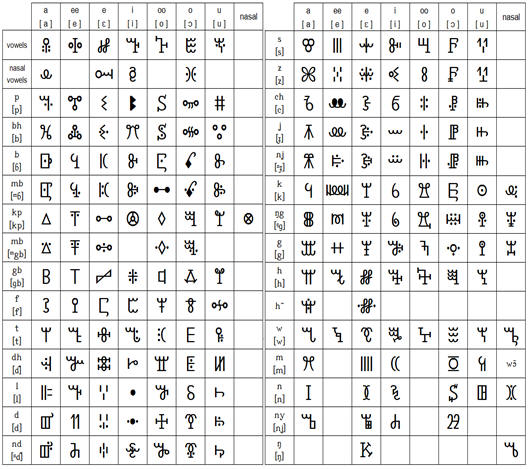 |
What: Writing Bamum:
Writing Bamoun hieroglyphic was first
made in 1910 by King's Ibrahima N'djoya who created 466 signs.
40 years later, it gradually to the
muta alphabetical form around 1930.
Its sixth version, that of 1930,
contains only 80 letters.
However, the colonial occupation has
destroyed all schools Bamoum by burning after the first world war.
The founder of the Bamum system was
deported in Yaounde where he died two years later.
If scientists today have not
experienced the same fate as the founder of the Bamum, is that African
people no longer live under the colonial occupation.
As every age has its form of combat,
which is why the African writings are subtly opposed by néocolonialismes.
But unfortunately, the teaching of
national languages is reserved sector of Adult literacy while teaching
children occurs only in a foreign language.
This paradox is the programmed death of
African languages.
If our descendants will revolt by
denying their history, their origin and language, African when any record of
such languages have disappeared, it will be the doctor because after
death, nothing will give them a foundation for cultural them see reason.
The way to combat African languages
began long ago.
This spelled the end of some extinct
languages in Africa the last century by the disappearance of literature,
traditions and cultures.
The current literature does not inspire
parental realities, but realities imported children to master.
Education systems far from solving the
problem helps to destroy African cultures valuing foreign languages.
How the man looks like his parents,
that's how we perceive culture through its language.
Here is a specimen of the first system
Bamum: |
|
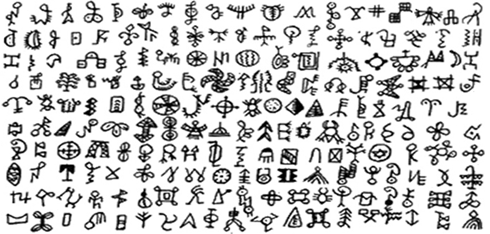
|
Cc: Writing MENDE:
This writing is the Kamala Leone Kisman a
syllabic system introduced in 1930 in Sierra Leone ... Here are his letters: |
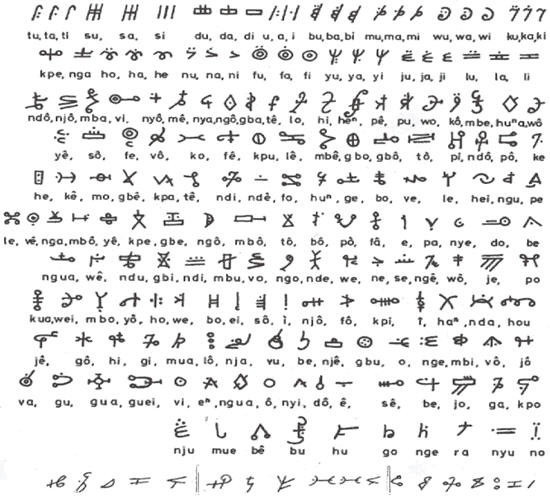 |
Despite the similarities between this
system and Vaïkan gbodo he is writing from right to left using 195 signs while
Vaïkan gbodo goes from right to left.
But the colonial government opened schools
for Latin literature Mende in Latin and then in English.
Learning difficulties of Mende, syllabics,
next to the Latin alphabet, simple, and the imposition of European language in
everyday life and in the administration took this scripture to disappear
gradually after a century.
Writing Massaba:
It is a syllabic writing system created in
1930 by Woyo Koulibali.
Here are the Massaba Syllables. |
|
Writing Massaba includes 123 letters and
was founded by the Massassi Bambara Kaarta.
It was developed under the model of the
seven vowels of the system Mandingo.
However, these signs are found in their
syllabic pronunciation.
As there is no vowel to connect to
consonants, all signs are syllables.
In the conception of writing, syllables
absent from the Massassi Bambara Bèlèdougou are also absent from the system.
It is as if the Vai where r is also absent.
Any signs absent from native speakers of
syllabic scripts are not in syllables.
This is a common feature
systèmessyllabiques.
|
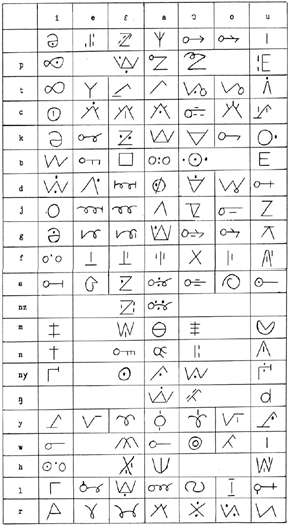 |
|
Cd: Writing African syllabic Loma: |
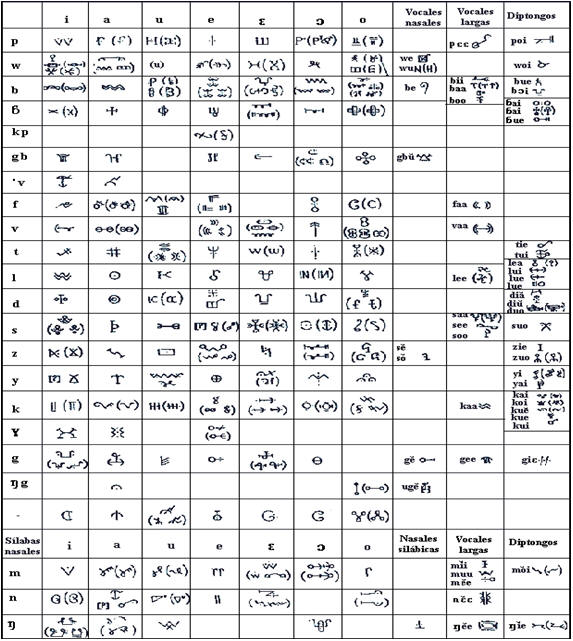 |
The syllabics Loma was founded in 1930 by
Wido Ezeketa.
It has 185 letters.
Its characteristics are close Massaba.
It was developed to transcribe the Loma in
Liberia.
It reads from left to right.
There is almost no longer used today.
Here are the letters of the script Loma:
What: Writing African Gbèlè:
This is a script created by Gbili Sanoye in
1930 and has 88 letters.
It is also the model of the seven vowels of the Mandingo.
Syllabic scripts like the same kind, the
Manding people Guele is a non n'kophone at the border between Guinea and Sierra
Leone.
Here is a specimen of letters gbèlè: |
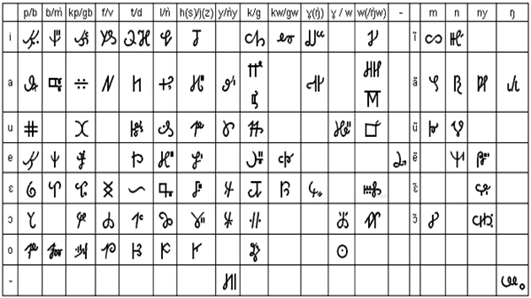 |
|
Da: Writing Bassa: |
When the founders of African writings used
the syllabic systems since the first half of the 19th century, the advent of
writing BASSA took a few changes.
For entries can syllabic vowels represented
through the letters, but they can not interpret the consonant vowel combination.
The evolution of writing Bassa, syllabic
initially becomes progressively vowel and consonant.
Bassa were signs of more and more reduced
with 35 letters including 23 vowels and consonants 7 5 with diacritical marks
for tonal.
These signs Bassa: |
|
These two tables represent the consonant
system Bassa. |
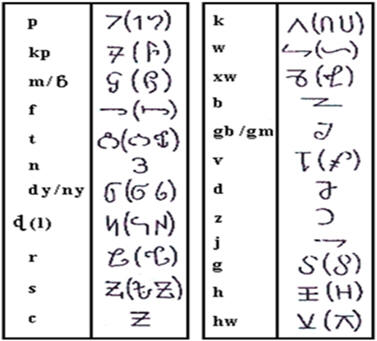 |
|
The following table shows the vowels of
Bassa and tonal notations.
The i is the first vowel. |
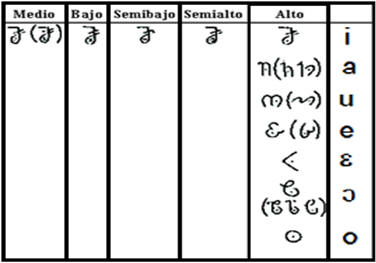 |
Some argue that the Bassa was founded by
American Christian missionaries in 1920.
Today, I have reservations because Latin is
the writing of American missionaries.
In their travels, they took the Latin.
How interested they could abandon their
writings to create a different alphabet.
That is why I believe that one must
separate the Bassa of the missionary.
This does not exclude the fact that its
founders are Christians.
Thus, when there is development in Africa,
still it is attributed to foreigners.
This is what will be the case, we shall see
later Wolof and N'ko |
Db: The phonetic N'ko:
It was founded in 1949 by Solomana
Kante, it has similarities with the Bassa by the existence of vowels,
consonants and tonal notation, but differs from it by its own merits.
We will complete our research by N'ko,
we took him here for the history of partition systems.
Here the alphabet N'ko presentation: |
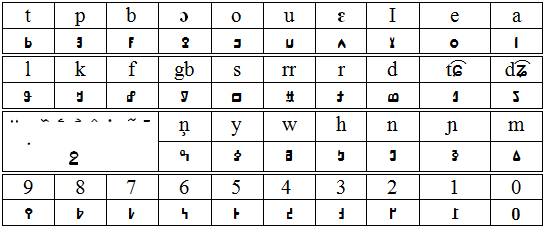 |
E-: Writing Wolof:
This is a writing system invented in 1960
by Assane Faye.
It includes vowels and consonants.
A total of 25 letters and 10 digits.
Vowels are not counted in the alphabet.
This is a non-phonetic writing like other
writings and consonant vowel. |
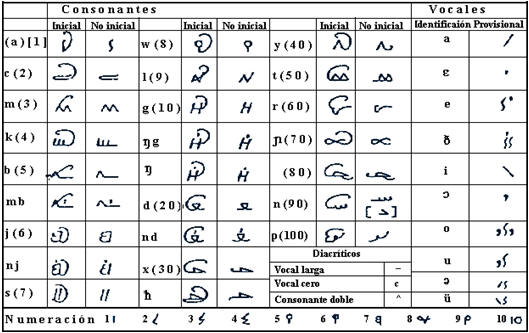 |
Ideogram and phonetic:
If we talk about all the writing systems
invented by Africans, it will be a little tight here.
Other systems are left to talk about the
last di kind.
A-: Writing Mandombe:
This is a writing system developed in 1978
by Wabelazo Payi for African languages.
The Mandombe is a cuneiform whose founder
was inspired in the region of Mbanza Zoungou Congo and Congo Brazzaville sea.
Punctuation in second position takes the
place of vowels intermediate; |
|
Consonants are in the group combining the
basic layers.
First, the consonants are added to complete
the basic radical.
Refers to a form right and left as in group
1.
The second concerns the vowels, vowel and
basic derivatives, he joins a basis for |
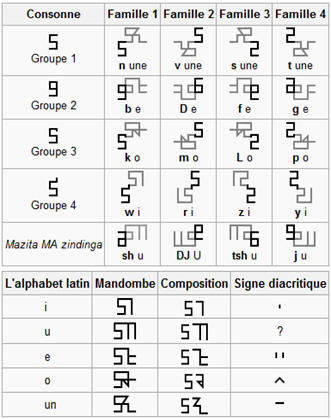
|
become like the second group; The third
is the combination of the vowel in up or down as group three.
The fourth group is the association of
vowels, consonants on an external tooth as the bottom line. |
Note:
Vowels and different basic positions do not
lead to a no vowel change.
As for writing N'ko, the letter w [ߓ]
returned becomes pa [ߔ] reversed it deviate the number 3 [߃].
All this in Mandombe is the same.
When each consonant, it becomes changed in
each group.
We can make a difference in the writing
this way. |
|
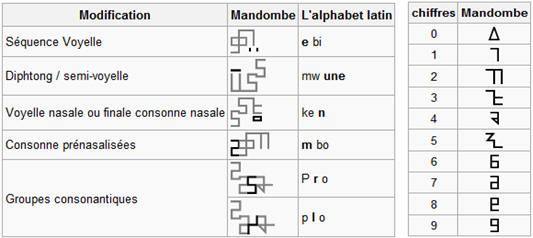
|
In this table, you can you help
yourself with the French:
The Mandombe also contains figures.
Look at the top right of the table.
Our last alphabet is a true alphabet.
Its founder intends it to the whole of
Africa.
It must be in conjunction with the
promoters of the alphabet for each N'ko shows the capabilities of his
writing.
Here is a text Mandombe below: |
|
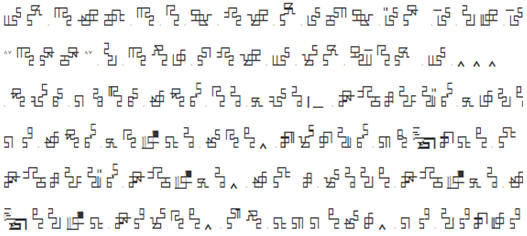
|
Given the multitude of African writings, we
are all summarized.
The greater part of these writings were
founded in the 19th and 20th century and eventually disappear.
The nature of these writings and their way
of promoting them have not reassured their future.
The people for whom these writings were
created today are not aware if these writings existed. |
|
Bassa and N'ko are consonant and vowel entries and
tonal.
An example of vowel and consonantal script.
An example of vowel and consonantal script.
|
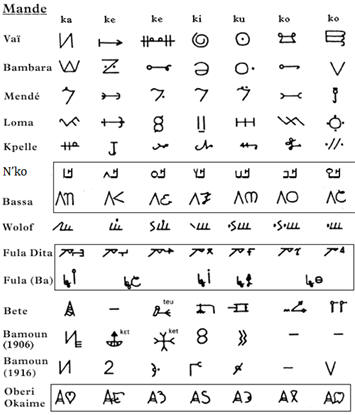
|
African writings of all these listed, there are some who
survived.
We will present them in writing to the
parties appearing widely distributed and very old.
We begin by demonstrating the skills of
the alphabet N'ko.
After the others will follow. |
The alphabet N'ko:
Db: the phonetic alphabet Africa (N'ko) was
created by the researcher Solomana Kante in 1949.
It's just like writing Bassa (for the idea
of existence of consonants vowels), however it differs from it by its
peculiarity of transcribing foreign languages and letters of reserves.
His name [N'ko], that name is built on
behalf of the common language of the Mande empire by Kante as he showed in his
book the "big five questions and their answers."
The N'ko was founded when Mr. Kante was
four years described in the Arabic alphabet and three years the Latin alphabet.
Each time he reached the grammar and logic
in Arabic and Latin, he was stalling, so he had already added other words of
himself in order to adapt to the common language madingue, by vowels and
consonants.
Willingly this system, these scripts have not been the language
of his paper.
As he heard one day, in the conversation of
his friends that: (Djaaka, take the knife and mailings), when it lasted but not
send.
He heard yet: (there is no knife there?).
Thus, it was found that the indeterminacy
of the word (the knife) is (a knife).
That's where he knew the value of your
before inventing the alphabet N'ko.
When he saw that these two entries can not
satisfy him, he was informed at the same time for the existence of writing
Fayika (a group of the Mande empire).
Instantly he began to learn while covering
that is purely syllabic writing and Fayika are the same ethnic group as him,
that's where he was made aware that God has not refused to create a new,
because he believed that the Almighty God who has revealed the Arabic script to
write the Koran.
To this end, he lost interest in foreign
alphabets and incomplete and difficult one syllable of his colleagues to take to
be based initiative to create a new alphabet rich adequacy to transcribe their
language and other human languages.
This is the fundamental reason for
initiating the Alphabet N 'kb at February 14, 1949.
Some say it is because of defamation of
Lebanese Gaamil Marwa who angered hence the idea of creating the N'ko.
Think again this irritation has found it in
a world to transcribe.
Eest is a simple irritation may directly lead anyone to enter
the room to create a phonetic alphabet, while focusing its language strictly in
science, and moreover capable of transcribing other languages already
transcribed and end with characters reserve for possible cases?
It is really difficult.
This proves that it is not this irritation
because he was angry the same way in Kankan before going to Ivory Coast.
One day he went to a priest so that he read
some literary expressions manika before him, for he may know the truth and
falsehood that his maternal uncle Soule said.
This story is this: the writing can not
transcribe all parts of the language but can do so that we can master the
difficult words.
His uncle said that because the history of Wassoulou who was
with him, in language manika transcribed in Arabic script, he who is better
educated than his uncle in Arabic, while difficult to read it read it quickly
because of tell it many times and not because of the writing itself.
It is this doubt that was in Mr. Kante.
This is what he came to seek the white
priest who knows more than he manika, because he has already translated the
entire Bible in manika.
The priest began to read the introduction while groping in the
pronunciation of words.
Asked the gentleman why?
He replied that this fault is not mine, it
is in the composition of your African languages.
This means that the priest has accused the
language and not writing, so that the fault is manika transcription in Latin.
The fault is the lack of correct
transcription of words and tones of language manika in the Bible and the priest
in the history of his uncle.
The researcher Solomana Kante himself accused African languages
by missing entries in transcript Foreign correct, because he believed in ready
as religious leader.
We can explain this because he had not yet discovered the secret
of writing and language.
He gradually corrected these errors in its
ability, in Arabic for four (4) years and Latin for (3) in his trip to Ghana,
except those among them insoluble in tone.
Writing Fayika he had considered that will
satisfy him: the letter [ߙ] who had no tone.
The fact that it is incomplete was added to
the difficulty urged him to rely on creating a new alphabet to apply all his
knowledge and desire in him after its creation.
The alphabet of 25 letters was in 1949 and
here the tone and their application:
[ߊ ߋ ߌ ߍ ߎ ߏ ߐ ߓ ߔ ߕ ߖ ߗ ߘ ߙ ߟ ߛ ߜ ߝ ߞ ߟ ߡ
ߢ ߣ ߤ ߥ ߦ] at that time the letter [ߣ] not vocalized was [ߣ ߵ = ߒ] and [ߙ]
doubled was [ߊ] he added them to make up to 27 letters: seven (7), nineteen (19)
letters and medial consonants.
In 1980, he has embellished three (3)
letters [ߖ ߗ ߙ] and considered [ߊ] letter as free as [ߒ] was already free in
place of [ߣ] apostrophe.
When the tone, we put [ߑ] as an apostrophe in the middle of
words.
Also show how to write the words in these
different approximate consonants already known.
Based on this his students have generalized
this to the creation of several letters of reserves, which proves the celebrity
of N'ko. |
|
TABLEAU |
|
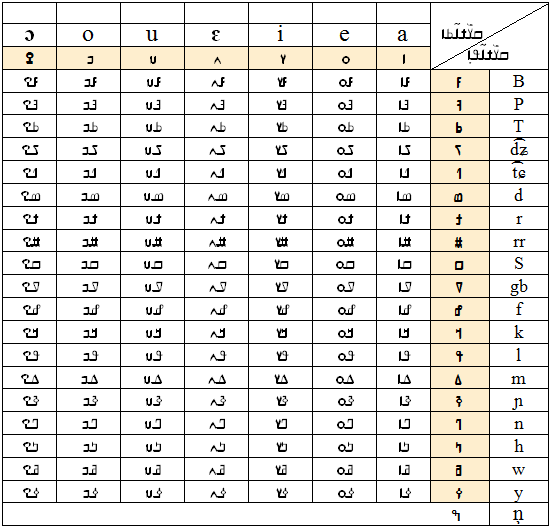
|
|
The transformation of the pronunciation of
each of the seven (7) tones and vowels by their additions. |
|
TABLE |
|
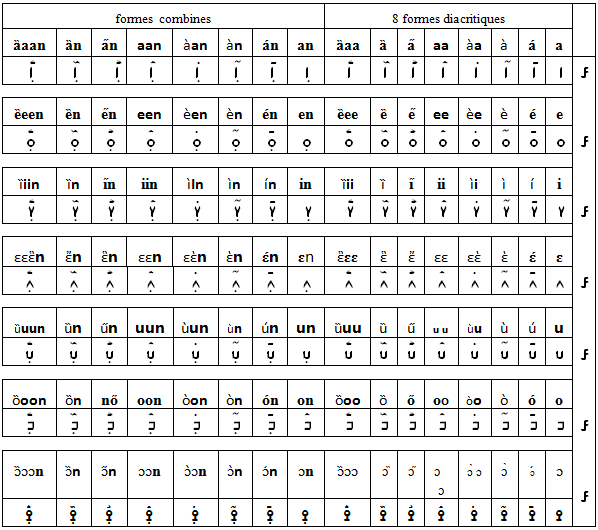 |
This table shows that a single consonant can be vocalized by a 16-way kind of
vowel.
This proves that the way the first table was composed of simple consonant, we
can compose 16 of the 2nd in the table just for 2128 syllables in addition to
this, the 8 tones ߒ'''' where all the is 2136.
These are the two previous tables which are original letters of syllables N'ko.
These
letters contain no diacritical mark.
As for
the letters approximate, it is these two points [߳] only which are the vowels to
show their pronunciation approximated as follows: [ߊ ߳ ߋ ߳ ߌ ߳ ߍ ߳ ߎ ߳ ߏ ߳ ߐ ߳]
from there they become consonants when they vocalized in this direction.
They can
be as vowels when we hear that their approximate expression in another language
such as: [ߊ ߳] is (a) Arabic is pronounced in the larynx [ߊ ߳ ߊ].
The seven (7) and its derivations such as vowels [ߋ ߳ ߎ ߳]
are the approximate expressions of our letters [ߋ ߎ] in French.
As for
consonants, each diacritical these doors [߫ ߳] to approximate his letters as his
letters: [ߛ ߛ ߛ ߳, ߜ ߜ ߜ ߳].
From
there, the vowels are derived once the consonants and three times, then we can
build on each:
The 19
consonants approximate dotted TABLE |
|
Les 19 consonnes approximatives en
pointillée TABLEAU |
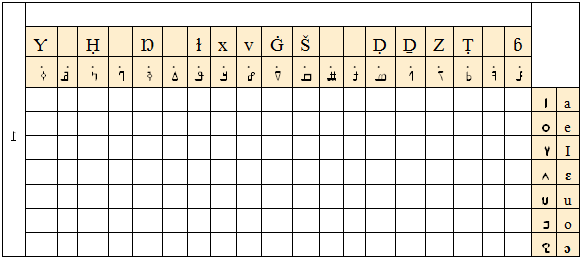 |
|
The 19 consonants with approximate shot above TABLE |
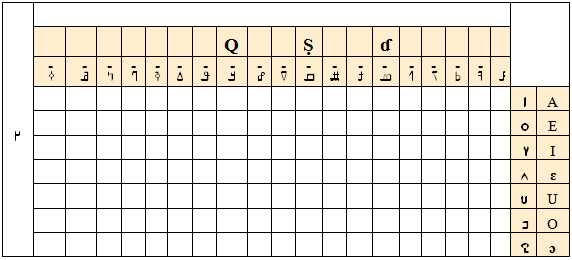 |
|
Les19 consonants with approximate two points above TABLE |
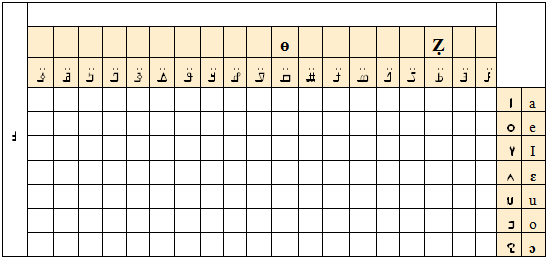 |
Note:
-
[ߣ ߠ] = [ߢ ߧ] are all the same in pronunciation, it is a grammar rule that
applies.
-The rest of the letters are 10 and these: [ߋ
ߊ ߴ ߵ!
ء ߋ ߊ ߊ] mean: apostrophe,
the two signs for the absence of loud (ߴ) and low (ߵ), the interjection, the
small o (ء), the comma, and the scientific unit as: [ߜ ߊ ߞ ߊ ߛ ߊ ߜ ߗ ߊ ߜ ߥ ߊ]
mean that the meter, kilogram, centimeter and millimeter, because there is no
appropriate letters to represent N'ko.
As for N'ko own name, he ended with the sudden voice and in Latin it is started
by a capital letter.
The researcher designed the alphabet so that the seven vowels can become other
letters with the reserve that do not exist in others.
The N'ko widened in the rough letters to transcribe foreign words correctly.
The fact that the Arabic script and Latin writing prior N'ko.
They are
seen as tools that keep the inheritance for centuries, this is where they have
influenced our names and our own words.
So who
can contradict the lack of time?
This is why we can not read 10 city names and 10 names of families in these
foreign writings.
This is
what transformed (mended) in (Mali), (Mansa Moussa Kanku) in (Mansa Mansa Musa),
(chum, chum) in (keita), (Konde, Kone) in (Konde, koné), ( Kande, Kante) in (Kande,
Kande) up to the point where we consider we had almost the same as some family
names in their own right.
Apart idiogram, when we see the letters as the picture of human expression,
according to the principles of the language which they founded, we see that they
differ from each other by their ability to photograph the sounds.
It is
recognized that capacity in the multiplicity of syllables which are composed to
form different words, and syllables are grouped into one sound.
This
differentiation is known throughout the following points:
· If the alphabet consists only of consonants without vowels, so
the tone that shows the different vocalizations of a single letter, all letters
must be multiplied by that number, for example oussoumaniya and wölöfö.
·
If the alphabet is sylabique, the number of all possible syllables that
constitute it, eg the alphabet of fayika is 210, Bamou, Massaba and other
African writings.
·
If the alphabet consists of consonants and vowels, can be explained by the
number consonant multiply by the number of vowel as Latin.
·
If the alphabet consists of vowels and consonants in which the tones are
required, recognizes its number by multiplying the number of vowels and
consonants by numbers by the number of tones.
·
As for the alphabet which believe his letters, his ability depends on the
letters to which they turn.
If this
is the only consonants such as Arabic, consonants, vowels and tones as N'ko as
he did in the use of approximate.
Having produced this information, here is the comparative ability of some
alphabets: |
|
TABLEAU |
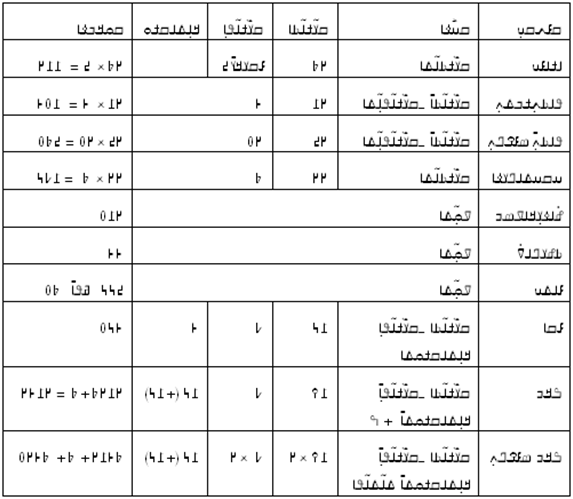 |
So
what is this comparison that shows the ability of alphabets into force, by the
use of phonemes and syllables to write human expressions.
In this table, writing the following Bamu N'ko in multiplicity because this
three times and write some.
The
Roman script is the first Latin edition of its 105 syllables and a half times 20
equals N'ko not expanded.
Form
extended by the use of consonants and vowels is 480, then it is 4 times that
number which is the capacity of N'ko unextended.
At the
moment there are no keyboard can use these 480 syllables of Latin extended,
while the keyboard N'ko wrote his 2152 syllables correctly.
If we expand the N'ko writing, we will have 9 times that the write constraint
Latin in it.
_If you vvoulez you can compare it to other N'ko alohabets.
Apart
from writing Latin, the syllabic alphabet is composed of vowels and consonants,
are around 180.
These
are the languages in the alphabet phonétiique that exceed this amount because
the language of these nations is highly developed in tone and it can not exist
without these tones.
_apres
all if we create a beautiful writing-based Writing encienne, through which other
languages can the resemblance.
To this
end we have to sustain it by combining some or other order that it can etr
automone at any time and any time.
the hardness of a language depends on its state
some languages depend on the behavior of his first locular
some depend on the persistence of living his life as:
The 1-writing the state will participate in many things, before reaching the
goal of its founding as a memento of his or object indicated.
As this
memory is cleared up, showing her things listed, it encourages perseverance and
encourages learners to master, in addition to maintaining the world of writing.
This mastery is as we always use the language in the names of things in itself
by their sign, as (Yiri) reminds the human beings that grow from the earth (the
tree).
That's what this expression shows.
The actual writing (Yiri) with its tones is (yi) and (ri).
This
process facilitates the connection between written expression in oral and vision
as oral expression as defined in the first position.
In this case we will say that how to write, speak and meaning are all together
in consciousness.
In the
case Ouu writing is not the image of speaking, this will reduce its life by
changing or transforming into others.
Hence, the alphabet can become syllabic in consonant or vowel consonant yourself
or others.
All of these are not serious if it reaches the goal of its
founding, however, their comparison proves the ease of one relative to another.
By a retrospective summary of examples in each write, you will see that some
have complex problems that are difficult or impossible to solve.
2_ The first dignitaries of the alphabet have a big role in his actions, namely
its commitment to master it in a real sense, that is to say, if a defect in it,
treat it before that it is common with this defect.
Also it
is not to be discovered that default by another people.
Any time
the absence of an alphabet is discovered, someone will always try to fix to
improve it.
Often
can be improved writing another script in hand as the Phoenician script has
several branches.
It
encourages its founder to his promotion in any place and any time.
This
will make sense of human civilization, man is always changing its reports.
To this
effect will always be dominated common in its reports.
Based on this, if there are no successors sincere in his actions, there they go
down to the disappearance.
3_l'alphabet itself is good, however he has to make concrete works at any time
for its development potential.
These
are works of literature, science and tradition, if the existence of these three
has proven true in writing, it will be because it is their perpetual reservoir.
Then we say that writing is a tool that improves human language through which
all his thought could reach.
Oral literature on which it relies to clarify, this is what made men has its
instrumentality conservation.
If this
is not the case, writing is a simple pleasure or a toy.
So hardness and safeguarding and improving the instrumentality of writing we
have just described above in the fact of a good product or a product close to
the goodness.
For its hardness, if you notice in the different alphabets explained above, the
hardness at any time and any place depends on the degree of existence of
elements of hardness.
It is for this reason that men of N'ko pledged to write literature, history of
the Mande empire, its classic and modern lifestyle in N'ko.
And
commitment to develop the rhythm of today's world with major languages that
are ahead of us for whom French is the first, after it has Arabic English and
Portuguese.
In the aspiration of men N'ko, they must draw on the trail of these great
languages that preceded them in the great scientific discoveries in all fields
to serve humanity.
For this
purpose it is necessary instruments for that participates in this science, but
technicians have already solved this problem for the people involved.
This process has greatly assisted the N'ko that there are in the electronic
world, to participate together with the advanced nations in their education
systems within the company.
That's
just the N'ko be initiated in implementing this system.
The primary alphabets of Africa
After having shown the status of all these alphabets, after noticing their
birthplace, it was seen that the alphabets improved primary and one that can
evolve by getting rid of all obstacles, the alphabet are not many alive.
Because
most African alphabets have disappeared the last century and exist only by their
names in its history.
N'ko observational writing is one of them with us in West Africa.
And that
expressed the primary east-called "Greek or Ethiopian."
The fact of comparing the writing "Bgèssi" in N'ko, the gap between them, as is
the age difference between writing to the ancient origin and recently.
One is
based for centuries while the other has not even a century.
So the
comparison proves liveliness in action.
If the young and old are equal loading in the burden, we say that the old is
famous.
On the contrary if the young and old are equal in knowledge of
history, we say that the young person is famous.
Hence if
a young teenager at the age comes to know its origin and how the actions of his
ancestors more famous than his friends promotion, then the one who observes the
adult age, this would not he a great event.
To this end entries are dying and new coexist in those places, they are in
schools and university in the world, the "Oussoumaniya" in Somalia and "Madombé"
in Democratic Congo.
Regarding the N'ko, I ask all leaders to kindly humanist sense of foundation
within the meaning of its founder.
That is
to say, a writing that can write all human languages especially those in
Africa that are essentially phonetic.
Its name
derives from it a general name of the Mande Empire is the name that was renamed
to him again.
By
observation we can say that this will only strengthen it.
After obtaining our own writing, so be quick and direct in the writings that
will serve us for our freedom in the world of literature.
I say
this because we have not before because the world is created from.
I
address this message to all the people of the Mande empire, I mean all its
different dialect and all Africans and all other Fulani of the world.
What makes that hear and obey.
Amen! |
THE ORIGIN OF THE ALPHABET N'KO
We can not close our research without some logical explanation of the alphabet
N'ko.
Alphabets created in the 18th century are called by those who
like africanisent African alphabets.
That is
to say alphabets whose property is lawful to Africans; alphabets that have no
influence or foreign inspiration.
For those based in the 19th century, are considered alphabets that were inspired
by precedents.
These
alphabets can be vowels and consonants, or phonetic alphabet such as N'ko, Wolof
and Fulani.
Then
must the events are recounted at fair value to recognize the value of African
thought.
From this, we will choose the N'ko as a sample of all African
alphabets:
As for me that we are all human beings, this is what has brought our visions in
the observation of facts.
This is
true even if we are not the same background or speaker of one language and that
is why it is usually on behalf of one (1) to ten (10) in all languages.
Hence, no one can ever say that a language has taken it to another then they are
not the same origin.
All things taken in nature that unites them are the same or approximate when one
has not borrowed from another, this reflects the fact that everyone has been
through the same origin in the middle.
If man
makes his actions through nature is what it will be good in his life.
To be clear in the details of things, their name is usually in their composition
and color, they are not often seen in different views.
For
example if observed by a researcher in one direction, day or another will arise,
he will find the same sense in them unambiguously.
In research, we believe that the last draw of the first, it may be that the
latter follow the founding of the first.
Yes,
this is true, but it may be that the latter are not inspired because of the
first mode in which the first was whether the latter are the same, they will
engage in the same way as the previous or in another way according to the
relationship between time and environment.
Some people imagine that the last scientists are always guided precedents,
especially if there was a connection between them.
This is
why some say the foundation of the researcher N'ko Solomane Kante was inspired
by Arabic in order to succeed.
This is
not the case, because he considered the traits against the traits of
dissimilarity similarities.
It
continues to say that most N'ko letters are letters shaped in Arabic and Latin.
From the
moment where some believe so, then you, you believe otherwise.
From
there, we have to prove it so people are aware of the fact in the real sense.
That's what pushed me Diané Baba has explained the history of the alphabet N'ko,
its forms and creative thinking.
Please
wait, we will reach them right away:
The researcher Solomana Kane did not detail the construction of the letters in a
book.
We will then go to what he told us, his manuscripts and works.
It is
they who have been very helpful in determining their forms.
-In his own stories, he began construction of writing N'ko similar traces by
100, then he chose the prettiest of them and appointed.
He told
this story well.
-In his own stories; between writing and image, the writing began to use the
image of things as writing.
He
showed the example of N'ko by the letters] and ߛ [ߝ and it is so far in one of
his little books.
-
In his work, he chose the construction of vowels and tones that expressed
exactly.
The same process was used by certain vowels as] ߛ, ߝ, ߢ [except
that you can not show that.
It is
they who are the first derivatives.
In our
estimate of the concrete vision, ߊ] [has no other meaning than the opening of
the mouth, ߋ] [as has no other meaning than the narrowing of the mouth, and ߌ]
[is the opening of the teeth ...
So those he has told us their names and those he has not told us which we see
their names in their images are explained: |
|
 |
The letter [ߊ] it was chosen by the pronunciation of the 100
signs cited, because it is expressed by opening his mouth.
The
mouth begins to open the top down.
It is also said to derive from the Arabic as it is the
opening of the mouth down.
It is a consonant whole vocalisable in three different
sounds (a, i, or), while in the N'ko it takes all the tones possible. |
|
 |
|
The letter [ߋ]: this is how to pronounce his name that makes choosing the shape
of a circle among the 100 cities. |
|

|
|
 ߌ ߌ |
|
The letter
[ߌ]: she was chosen among the 100 like the previous one, but it is
pronounced by opening the lips on the teeth.
By observing
it looks like the spacing of the two lips with a rod in the middle so as not
to confuse his writing to that of [ߎ]. |
|
 ߍ ߍ |
|
The letter [ߍ] is taking [ߌ] by reversing simply because it is
difficult to derive. |
|
 ߎ ߎ |
|
The letter [ߎ]: this is how to pronounce his name by the
narrowing of the mouth, which makes choosing among the 100 signs.
She is
still as if you put your foot an iron rod and flexible you take the two ends to
curl.
Then the form data will be nothing but a curve in this way [ߎ]. |
|
 |
 |
|

|
The letter [ߐ]: this is how to name the shape of a ball that she was chosen of
100 signs cited.
From
there it is inflated by a rod down to not whether the state posed as [ߋ].
That's
what the researcher Solomana Kanté differentiated letters of N'ko, not even look
like they do for one who writes badly.
The letters do not resemble N'ko, that is to say it is different from one
another. |
|

|
|
The letter [ߓ] = (ba) means river, is the way to express his name who did it
choose this way.
Its name
comes from two parallel lines as the banks of the River Niger.
If you
stop to his side is, you will see the flow from left to right.
And the
stem in the middle is for the sequence and to differentiate it from other
letters. |
|

|
|
The letter [ߔ]: because of complexity of having the image of his
name that was directly derived from [ߓ].
The letter [ߔ] is used in some dialect of Mande (ߔ ߊ ߔ ߊ ߔ ߊ ߔ ߊ = ߓ ߊ ߓ ߊ ߓ ߊ ߓ
ߊ).
Imagine some foreign languages as a kind of [ߓ] as Arabic;
really deserves it. |
|
 |
The letter [ߕ]: indicates the fire, his name was chosen from
three stones of a hearth and its flame.
This
home was divided vertically into two and neglecting the other flames in favor of
the central flame.
For one who faces this home split into two equal parts, if you are told to
choose one among them, although I think we will only choose one that is closer. |
|
 The
origin of the first form of the letter (ߖ) classic N'ko The
origin of the first form of the letter (ߖ) classic N'ko |
 |
|
The origin of the first form of the letter (ߖ) modern N'ko |
 |
|
The letter [ߖ]: this is how to train her name (dja) derived from (Djaba) which
means onion.
This is
the 4th straight portion of the cup of the onion far and wide and it landed on
trunk is surrounded by its roots.
If you
take the last layer and the root of his side, you will automatically have the
first [ߖ].
The 1st [ߗ] and [ߙ] derived automatically [ߖ].
One can
imagine that [ߖ] is similar to (ح) reversed from Arabic.
To avoid
confusion Mr Kante did cross a line for it to be in the line of writing N'ko
concatenation.
Such a
concatenation will disrupt N'ko writing from there, he kept it that way for is
completely different from the Arabic letter and for there to be consistency
between the letters of N'ko in the concatenation.
The
spirit of the letter comes as the onion so that the researcher in that of [ߝ]
and [ߛ]. |
|

|
The first [ߗ]
The letter [ߗ]: this is because of the complexity of obtaining her name she was
one of the derivatives [ߝ]
[ߗ] is taken from the back of the donkey but the first (Chadian)
comes from the first (dja).
So the first [ߗ] comes from processed [ߖ]. |
|

|
|
The letter [ߘ]: (da) means the door, its just there, the image
of two contiguous Protestant.
He
built the letters in this way it will be very difficult to mix or confuse. |
|

|
|
La lettre [ߙ] : à cause de la
difficulté d’obtention de son qu’on l’a directement dérivé de [ߝ] l’image de [ߙ]
. La 1ère [ߙ] fut formée d’elle aussi. Son point d’enchainement dans l’écriture
est à son pied contrairement à la première. |
|

|
|
The letter [ߙ]: because of the difficulty of obtaining sound
that was directly derived from [ߝ] image [ߙ].
The
first [ߙ] was also formed.
His point in writing is chaining her foot unlike the first. |
|
 |
 |
|

|
|
The letter [ߝ]: as the name suggests it was build in the ass
arrested and facing the right side.
Mr
Kante has shown this way in one of his book entitled: ................
Please
look there. |
|

|
|
The letter [ߞ]: it was easily derived from the part of [ߝ]. |
|

|
|
The letter [ߟ]: it is a derivative of [ߝ] in the facing left side while
suppressing the image of his hind leg |
|

|
|
The letter [ߡ]: it is a derivative of [ߜ] reversing, it is simply the opposite
of [ߜ] that is to say it is resting on the line concatenation. |
|

|
|
The letter [ߢ]: (gna) which means the eye, this letter is to build with an eye
eyebrows shot to the left and the lengthening of the nose which supports the
chaining of writing. |
|

|
|
The letter [ߣ] is also build on the donkey [ߝ]. |
|

|
|
The letter [ߤ]: This letter is also build on the donkey [ߝ] by cutting some
parts and adding a little horn. |
|
 |
|
The letter [ߥ]: it was build the image of a pedestrian walk.
the
letter [ߥ] in the concatenation is like walking towards you in your facing. |
|

|
|
The letter [ߦ]: it was designed from the swelling of the mouth, that is to say,
the letter [ߐ] by applying a small horn above it |
|
 |
|
The letter [ߒ]: it was designed on the donkey [ߝ] by cutting its two foreleg in
favor of those past and facing the left side. |
|
 |
|
The letter [ߠ]: from the moment it is considered the letter ['] turned into [ߠ],
is then designed in the same ['] for the relationship of the same origin is
preserved.
['] Is designed to image [ߝ] and [ߠ] also comes from ['] by cutting its head in
favor of a horizontal line. |
|
  |
|
The letter [ߧ]: from the moment [ߧ] resulting from the conversion of [ߦ].
This writing also comes from [ߢ]. |
As
for writing numbers most of them come from nature in this way: there were in our
literature by the stone (bere) and wood (Yiri) by doubling one to express a
number that is why is expressed by the quantity (bèrèya) or (yirika), that is to
say the number of rock which contains it.
On behalf of many, the word was used (yirika) which means the quantity or lot.
This is
where we closed the hand by drawing the index compiled for the express
consideration (a).
This can
be a demonstration to show something at the top or bottom.
This is
what has made ...... ߗ ߜ ߊ ߡ ߊ ......
The figure [߁]: it is built to the upright position of the index.
This
logic is unique in many nations do not borrow one to another.
The figure [߂]: it is built of two sticks together arrested.
To
shorten the writing we have cut the beginning of the 1st and 2nd glued to
maintaining their position.
The figure [߃]: this is a stick and stopped the other broken into several
pieces.
From there we stuck to the first two pieces stick to construct
this figure.
The figure [߄]: the idea of breaking it began its full number is four.
They are
the ones we chained to build the 4th digit of N'ko.
That is
to say it is designed combination of four sticks or a stick into four parts.
The figure [߅]: is an amount agreed upon, constructed of a single stick with a
tooth in the middle.
This
building is representative of the 5th digit of N'ko.
The figure [߆]: it is built of figure [߅] by passing his tooth left to its
vertical position distort as stair landing.
The figure [߇]: this is a [ߊ] elongated and broken to the right side in an
oblique position.
This
construction represents the seventh digit of N'ko.
The figure [߈]: this is a [ߊ] lying broken as [7] and to get a medium to form
the eighth digit of N'ko.
The figure [߉]: [ߐ] is a letter constructed of a circle that was always inside.
Then the
[߉] is constructed in the letter [ߐ] by lengthening it and cutting his foot or
base.
We explained that the letters Solomana the researcher has not explained.
These
estimates are like those of the founder because those are limited in explaining
mine are like that.
You too,
please observe your way to know its truth.
The number [0]: this figure to the shape of a circle, it's no surprise that it
took this to indicate simply an empty thing.
Zero (0)
means N'ko (sökolon) that is to say something empty.
As for
you any other sign that could be suitable in writing?
Because of its empty state that remains the representative of zero in all
accounts.
That's where we get to write all the multiples of two directions
from scratch: either beyond its value [ߓ ߎ +] or below it [ߖ ߊ -].
While these explanations are a few letters N'ko groups:
-
Those taken from the reflection of their pronunciation such as vowels: [ߊ ߋ ߌ ߍ
ߎ ߏ ߐ]
-
Those made in the image of a thing the empire known as the Mande [ߓ, ߕ, ߖ, ߘ,
ߛ, ߝ, ߥ]
-
Those resulting from the processing of images of these letters [ߌ, ߐ, ߓ, ߖ, ߝ,
ߥ]:
-
For [ߌ]: which is the mouth opening is reversed [ߍ] and is covered [ߜ], and the
form of raised [ߡ].
- For [ߐ]: This is a plant stem to the tips of a balloon for
[ߦ].
-
For [ߓ]: the built form of the river, its shape is transformed [ߔ].
- To

-
For [ߝ]: this is by cutting parts of [ߝ] for [ߒ] and ['] and [ߣ] and [ߤ] the cut
of [ߒ] well [ߗ] and [ߙ ].
-
From there, we say that [ߠ] just ['] and [ߧ] just [ߢ].
After having read and understood all these things it knows that writing N'ko was
created madingue of civilization.
To those who say it comes from a portion of Arabic or Latin for, really they are
far from logical.
As for some major events from all the great men, that's what made him famous
fans of our ancient civilization such as:
-
The Pharaohs of great African civilization.
-
The Cisse (descendants of men) of the empire Wagadu.
Posterity-Maga Soudjata as respectable.

It
is in the same way that writing is the concern of Bassa ready.
And make-believe that the writing of African dating from the arrival of European
priests at home and, while Arab preceded them.
-And consider writing N'ko like build foreign entries.
-Transform and the name of the researcher's mother Solomana, if it was not that
this is done before all of us.
The way we related the loan, if that is the case, this contradicts the reasoning
of Haliki.
What some letters coincided with those of Massaba Vayinkagbodo, while 2nd do not
know the existence of writing the 1st?
What is the count starts from one (1) to ten (10) in most
languages?

What has ................................................
From these explanations, we knew that everything they say about us is wrong,
comes from the N'ko Mandingo civilization as some researchers say.
We, we are the Mande, and know that these elements of our civilization are not
developed so they can replace writing.
We will
be summary in this part.
However
regarding the taking of N'ko in Arabic or Latin, what you have been developed in
this way.
Here the reasoning of those who say that the N'ko is Arabic; the N'ko is taken
from the Arabic and Latin:
that: [ߊ] of N'ko just (ߊ) of Arabic, [ߌ] of N'ko just (ߍ) of
Arabic in the middle, [ߎ] of N'ko just (u) from Latin [ߐ] of N'ko just (ߛ) of
Arabic in combination with the sign (?) questions.
However
we have not talked about the construction of [ߔ] N'ko of which comes from [ߓ].
The [ߕ] of N'ko just (ߓ) of Arabic

the [ߖ] of N'ko just (ߤ) of Arabic, we have neglected the origin [ߗ] of N'ko to
[ߖ] N'ko of the [ߘ] comes from the beginning of N'ko of (ߔ) of Arabic, the [ߙ]
comes from the N'ko (ߴ) of Arabic, the [ߛ] of N'ko just (ߧ) of Arabic, the [ߜ]
of N'ko just (ߗ) of Arabic in the middle of writing, [ߝ] of N'ko just (f) of
Latin, [ߞ] of N'ko just (ߕ) of Arabic, the [ߟ] just (ߋ) in Arabic, [ߡ] of N'ko
just (ߣ) of Arabic, [ߢ] of N'ko just one form of [ ߣ], the [ߣ] just (ߝ) donated
one of the Arab side of the [ߥ] of N'ko just (ߛ) reversed from Arabic.
After all his explanations, know that the smallest number of different versions
of an explanation of a fact is, this is what created the contradiction in most
events.
However according to the gossip always explain their vision but can be explained
only after the analysis of each case, it may give reason to any one of the other
because one will always remain.
Starting from the different versions attributed to N'ko, likeness or taken from
Arabic, starting rank of his letters as those of the Arab, proves that it
derives from the Arabic version according to some gossip.
We have
already explained our version of this resemblance.
If the
forms of two things are equal, we should ask the owner of at least one of them
to explain where he is, what it took for him?
If it
shows that it took him to the preceding, it is free to do so.
And if a
version that explains the grants to the invention, this explanation must be
obedient to his dignitary.
For
example the researcher Solomana Kante explained the origin of [ߝ] and [ߛ] of
N'ko, then they are very similar to (f) and the Latin (ߧ) from Arabic.
The
construction of all our letters already explained.
Taking the classification of letters N'ko to that of Arabic, although I think
this is not us alone.
If you
see Europeans speak today of 'Sosso Bala' of the Mande Empire, the nations of
other continents take part of the legacy of the pharaohs, the documents of
Timbuktu (RM) become universal, it is universal law of inheritance which has
caused.
The Fayinka (one of the names of the people of Mande) and their ancestors are
from the circle of the first nations who started writing.
Hence
their universality, from men that circle should be marginalized.
Because
writing is a medium, that is what made appointing most European scripts
(alphabet, ߘ ߊ ߖ ߊ ߓ ߑ ߖ ߊ ߘ) if I do not deceive such terms are Arabic words,
taken from the sequence of letters their alphabet.
This began with the alphabet [ߊ] and [ߓ] Arabic and the Arabs call [ߊ] "aliif"
and second "baaou".
That's
what made this sequel "aliif-baaou" and "alphabet" in European languages.
The ranking of the person who started with [ߊ = a], [ߓ = b] and [ߖ dja =] all of
the Arabic alphabet that was named "abadjada" then "adjabi" in European
languages.
Away from all this, languages are not similar, their alphabets
are not the same, they differ in the specific characters each that the other
does not.
Apart from these others have the same characteristics in the
alphabet into vowels and consonants or consonants only around 30 letters.
In the evolution of certain groups of men already literate in most nations.
When
this alphabet is 30 no matter how the alphabets resemble the recent past will
because they were already literate in them before.
It may
also have traits of dissimilarity between them.
It is this procedure that shows their alignment or uniqueness in the sequence of
different European alphabets.
There
are also some points of difference between them.
Their
reconciliation is a function of their ancient alphabet although they were not
owners of it before the creation of new, and nobody has pushed these recent ways
to choose one.
No nation can be exempted from the evolution of intermediate steps and general
evolution.
That's what Mr. Kante Solomana could be no escape from the
development of its community.
If it was for the organization that is personal, the way the vowels are N'ko,
the consonants are the same way in the rankings to differentiate them from all
others.
Hence no one can say that the ranking results of another.
One objective of N'ko is add to the alphabet of the Mande other alphabets are
missing, then show it in a form that will make it easy for everyone.
This is
what has made the current form of the sort.
Explaining otherwise, the letters of N'ko [ߊ ߋ ߌ ߓ ߕ ߙ ߤ] which closely resemble
those of Latin [ntbfyol] for what they do not express the terms of resemblance?
This
goes the same direction as the letters of N'ko [ߍ ߏ ߓ ߖ ߘ ߞ ߣ ߥ] it looks like
those that are transformed from the Latin as [6 L k B z F uv].
A
muddled can transform the meaning of your action except Allah Almighty help you.
If N'ko was inspired by the Arabic alphabet for his foundation and its
classification, we can also say the same manner he was inspired by the Latin
alphabet, the alphabet because N'ko includes 27 letres and Latin 26: 7 in 18 are
written in the same way, eight new letters in exchange for old and 2 are
equivalent in writing and in pronunciation that here [ߝ] and [ߎ] are [ uf].
Both
alphabets are composed of vowels and consonants.
For those who want to compare the two, this person would not he able to show the
approximation and resemblance of N'ko in Latin?
I think
this is easy if it was his goal.
To be precise it is the influence of our fellow brothers which is on us.
The resemblance between the N'ko and Latin is it not clearer than Arabic if
cella is proved?
Must be
mastered for your action that does not spoil him or sabotage in your hand.
The direction of writing N'ko:
Because they say that the writing of N'ko starts from left to right, it does not
matter.
From the time the first were meaning, then we are free to do
what you want.
Meaningful entries are meaningful only four: from top to bottom, from bottom to
top, from right to left and from left to right.
The last
two are the most practiced although the first two passable.
Writing
Koko practiced the last two and have chosen to feel themselves a sense among the
two.
Wholes in the right direction the facts are not many ways such as clothing and
acute way in the song.
Based on
this writing only two lines at present, we have to obey this reasoning.
Particular comparison:
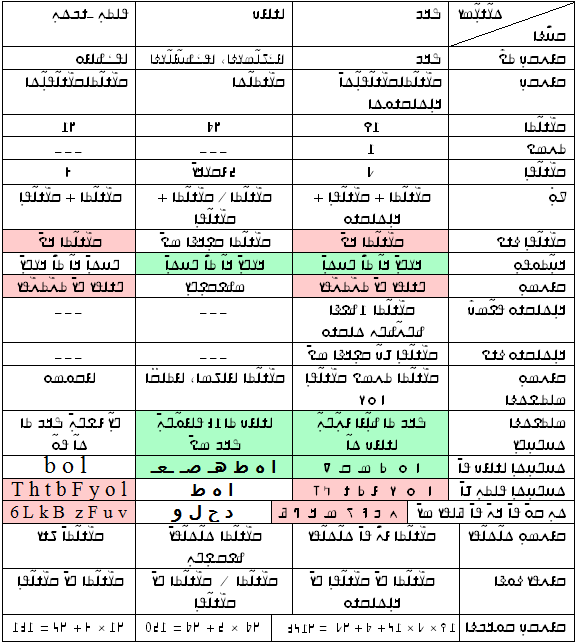
From this moment, we want to match our particular between ourselves N'ko and
Arabic, and between N'ko and Arabic that is to say the character to explain each
one in this comparison.
XSi comparison of the alphabet and was apparently the judge
based on that outside of the dignitaries, I was going to say that apart from its
meaning in writing, N'ko is very similar to Latin by the classification of his
letters than Arabic.
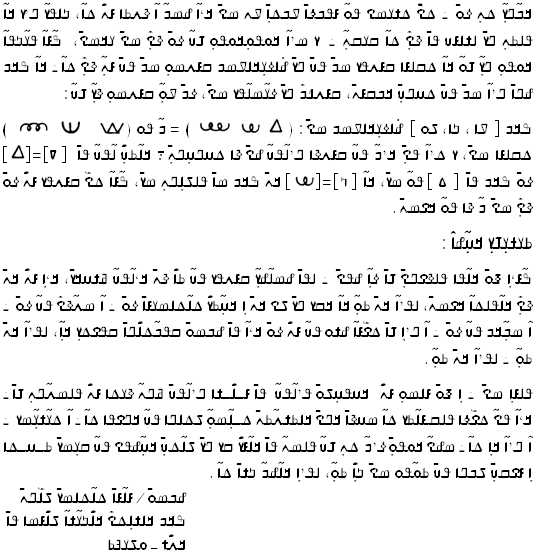
|
|
| |
|
|
|